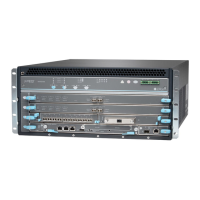3. Physically turn off the power and remove the power cables from the chassis.
4. Place the SPC on an antistatic mat or remove it from its electrostatic bag.
5. Identify the slot on the services gateway where the SPC will be installed.
6. Verify that each fiber-optic transceiver is covered with a rubber safety cap. If it does not, cover the
transceiver with a safety cap.
7. Orient the SPC so that the faceplate faces you, the text on the card is right-side up, and the EMI strip
is on the right-hand side.
8. Lift the SPC into place and carefully align the right and left edges of the card with the guides inside the
card cage.
9. Slide the SPC all the way into the card cage until you feel resistance.
10. Grasp both ejector handles and rotate them clockwise simultaneously until the SPC is fully seated.
11. If the SPC uses fiber-optic cable, remove the rubber safety cap from each transceiver and cable.
WARNING: Do not look directly into a fiber-optic transceiver or into the ends
of fiber-optic cables. Fiber-optic transceivers and fiber-optic cables connected
to a transceiver emit laser light that can damage your eyes.
12. Insert the appropriate cables into the cable connector ports on each SPC (see Figure 118 on page 299).
Secure the cables so that they are not supporting their own weight. Place excess cable out of the way
in a neatly coiled loop, using the cable management system. Placing fasteners on a loop helps to maintain
its shape.
CAUTION: Do not let fiber-optic cables hang free from the connector. Do not
allow the fastened loops of a cable to dangle, which stresses the cable at the
fastening point.
298

